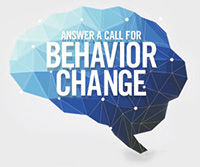
Dr. William Miller is the co-developer of motivational interviewing, and a leading authority on the subject of coaching behavior change. Dr. Miller recently spoke with ACE about motivational interviewing and how you can use this effective technique to help your clients identify and achieve their goals. Here is an excerpt from that conversation.
Motivational interviewing is a collaborative conversation style focused on change; specifically, to identify the client’s own motivations for, and commitment to, change. Fundamentally, it’s a conversation about change that is, in a way, the opposite of the interviewer (in this case, the health and fitness professional) providing the answers and the advice.

Develop Skills to Drive Change as an ACE Behavior Change Specialist
No matter how you work with clients and patients, effective coaching can further heighten the impact of your program. As an ACE Behavior Change Specialist, you’ll learn to develop the practical, hands-on skills you need to lead people to long-term, healthy change in one-on-one, group and virtual settings. And you’ll learn from the best. Our interactive learning experience features science-based, time-tested expertise from pioneers in psychology, emotional intelligence, motivational interviewing and coaching.
Take Your Expertise Further.
Learn more>>
Effective motivational interviewing is not about getting in people’s faces. It’s not gathering a lot of facts. It’s not dispensing uninvited advice and information. It’s not saying, “I have what you need, and I’m going to give it to you,” which is sometimes at the heart of therapeutic approaches. Instead, the message is, “You have what you need, and together we’re going to find it.” It’s not an expert dispensing advice. It is a collaborative conversation.
There are a lot of things that we consciously avoid in motivational interviewing. We call those the righting reflex—the desire to step in and fix things and make it right, to tell people what they need to do, to tell them why they need to do it, to essentially direct them in the way that they should go. Motivational interviewing involves a discipline of holding onto those things, of not just following your immediate gut instinct to tell people what to do and, instead, to assume that people have within themselves the wisdom and motivation to move in a healthy direction and to go looking for that. That’s a principal difference.
There are four component processes within motivational interviewing: engaging, focusing, evoking and planning, each of which is discussed below.
Engaging
Forming a collaborative relationship with a client is not something that has to take multiple sessions—the engaging process can happen within minutes. It’s a shift from the person waiting passively or defensively to be told what to do, to having a conversation about his or her life.
This is a process that is often skipped. In a brief consultation, there is a tendency to charge right into business and start gathering facts and dispensing information without an attempt to engage in the beginning. If you don’t engage, it’s very difficult to encourage change in people.
It’s communicating to the client that they need to be actively involved in the change process. It’s saying to him or her, “I can't change you. The only person who can make these decisions is you.” It’s recognizing and honoring the client’s autonomy, and having a collaborative conversation about how the client would like to proceed with his or her life and health. It’s establishing a collaborative, autonomy-honoring, accepting relationship.

Often, it starts with an open question, followed by reflections, with a goal of understanding the client’s perspective—getting inside how they experience their life—rather than trying to impose a different experience on them. Reflection is a very important tool, and not a simple one. People who are good at it make it look easy, but as you begin to try to do complex reflections, you’ll find it takes a little while to get good at it.
For example: “You sound discouraged. Things aren’t really the way you'd like them to be. You have a sense of what you need to do and also some doubts about whether you can really do it. What are the choices, then? You're not sure which way to proceed, so what are the possibilities for you?”
When you ask open-ended questions and reflect, which are the two things that I was doing there, and allow silence and a little bit of time for the person to respond, very often you get movement forward. It’s not that the person has no motivation or no ideas. You may have a client who says to you, “You’re the expert. You tell me.” In this case, I would probably give a little autonomy-honoring statement like, “Actually, you know more about your life and yourself than anybody else does, so I really can’t just dispense answers for you. But I’m very happy to talk with you about possibilities, to see what you think might work for you. We can consider different possibilities, but you're really the person who decides, ‘Will this work for me and how realistic is this? Can I really fit this into my life, and can I do it?’”
Focusing
Ultimately, you want to get a clear sense of where you and your client are going together. What direction are you moving? What are the goals? What are the things that you and your client are going to do together? Usually, it’s the client who brings those. For example, a client comes into the office and says, “I really feel like I’m overweight, and I’d like to do something about that, but I'm not sure what to do.” The client has suggested a focus, which, in this case, is to have a conversation about weight control.
Sometimes, you may have a goal that the client doesn't necessarily share or is ambivalent about. If you work in a smoking-cessation clinic, nobody wonders what you’re going to talk about, but people who come through the door are probably ambivalent about quitting smoking. The focusing process there involves bringing them on board with that goal and making sure that we are moving in the same direction. That’s where motivational interviewing, at least consciously, builds on, and goes beyond, client-centered counseling.
There's a goal we're trying to move toward. We used to say a directive. I think that was probably misleading, because it sounds like you're taking charge and doing it for the person. Now we say there's a direction to it. Motivational interviewing is directional. We know where we want to go with clear health-change goals here, and we have ways of moving in that direction, so it's not just following the client wherever they go, but consciously moving toward a focus, toward a goal, and establishing those goals or getting at least a temporary next step focus is the second process in motivational interviewing.
Evoking
The third is evoking, which you can’t do until you know what the goal is. If smoking cessation is the goal, now the process is calling forth the person's own motivations and their own wisdom about how they might do it. This process is fairly unique to motivational interviewing.

For example, consider this line of open questioning: “What would be the good things about stopping smoking for you? How do you think your life might be different?” The client's answer is likely to be the very things that you asked about. This is the opposite of telling the client how their life would be better if they stopped smoking. It’s much more important for the client to voice those things, because if you (the health and fitness professional) voice them, the client’s response is more likely to be ambivalent and along the lines of, “Yes, but…” and he or she will talk about why quitting is so difficult or what is enjoyable about smoking.
Ironically, when we do the thing that our gut tells us to do—which is this righting reflex, when we take responsibility for the good arguments and tell them why they should change and how they could change and how important it is—we're evoking their ambivalence, because both sides are inside the client. If they argue against change, they tend to move in a non-change direction. They talk themselves into or out of change, depending on how you arrange this brief consultation.
The skills that a health and fitness professional needs to develop to be able to do evoking is first to recognize change talk, to tune your ear so that you hear it, and also sustain talk, which is the opposite side of the coin. Change talk is anything that a client says that actually moves them in the direction of change.
Psycholinguist Paul Amrhein says there are many different kinds of talk that you’re mixing together when you talk about change talk. There’s desire, which is reflected in statements that start with things like, “I wish…” “I would like…” or “I want to…” There's ability talk such as, “I could…” “I think I could…” and "I'm not sure if I could…” There are reasons, which have an if/then quality: “If I quit drinking, I know my wife would be happier, and I'd probably feel better in the morning.” And there are need statements, which have an urgency about them: “Something’s got to change. My marriage can’t go on the way it has been. I have to lose weight. I've got to stop drinking.”
All of these types of statements have different linguistic functions, but none of them are a commitment. To say, “I want to” is not to say, “I'm going to.” To say, “I could,” you’re certainly not saying, “I will.” To say, “I have a lot of reasons. My wife would be happy, and I’d feel better,” is not saying, “It's going to happen.” Even saying, “I have to,” is not saying, “I will.” We talk about those four kinds of talk: desire, ability, reasons and need. We're listening for them early in a motivational interview, and arranging the conversation so that we hear more of those things.
Then there is the other side of the hill. While preparatory talk feels like walking up a hill, mobilizing change talk is more like heading down the hill in the direction of change. Commitment is one of the forms of language: I will. I'm going to. I probably will. I think I will. I promise. I swear. These represent varying levels of strength of commitment. We also look at activation language, which is not quite committing. “I'm willing to stop smoking.” Almost there, but not quite. “I'm ready to. I plan to.” That’s getting very close to commitment, but not quite there yet.
Finally, there is language related to taking steps in the direction of change. “I got rid of all the cigarettes in my house,” for example. Or, “I bought a pair of running shoes this week.” These are little things that represent steps in the right direction. We understand much better the different forms of change talk and their different functions, but the essential idea is that all of these are statements that move the person in the direction of change.
Planning
Once you have a sense that the client has enough motivation to move forward with a clearly defined goal, the next process is: “How could you move forward? What would be a next step? What are the options here for achieving your goal? Let’s consider those, and tell me what you think. Which of those seem like it might be a good fit for you?”
Keep in mind that these aren’t linear steps. In a way, you do engage first. You need to have a focus before you know what to evoke, and usually you evoke motivation before you start planning, unless the person comes in and says, “I want to stop smoking. Help me do that. How do I do that?” You don't want to spend time talking about ambivalence and why they want to or don’t want to or whatever, so you go straight into the planning process.
This is usually the sequence, but there’s a lot of doubling back. The focus can change. Something happens so that a different goal is much more urgent. You have a new lab test or an accident or something has happened, and the priorities shift around a bit. Sometimes, you’re working at a plan and the client begins to look reluctant and starts backpedaling. They aren’t really moving forward, which suggests you need to go back and do some more evoking. There is a great deal of flexibility within the session among these processes.
Don’t Take Shortcuts
So often, in part because you may feel like you don't have much time, you jump right over engaging, focusing and evoking, and talk about how to do it. How many of your clients actually do the things that you recommend? The problem is jumping over those other three processes and assuming the person is already ready to change and all you have to do is tell them how. Even if they are ready to change, telling them how is not necessarily a good idea.
If your client asks, “Tell me how I can increase my upper-body strength,” that’s an invitation for you to share your expertise. I would still do it in an autonomy-respecting way that says, “There are a variety of ways you could do it. Let me show you some, and we’ll see which of these might fit into your own routine.”
Why has motivational interviewing been disseminated so widely? It’s not from extensive marketing. It’s not because people have believed my arguments and accepted those and been converted by them. It’s because people try it even a little bit and find that clients respond differently. You simply see movement in clients, and it becomes less of a wrestling match where you're trying to defeat the person and make them do something. It’s also a lot more fun and a lot more effective.





 by
by 





